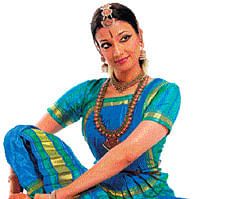Danseuse Savitha Sastry revels in the magnificent possibilities of traditional Bharatanatyam, lending the dance form a contemporary flavour, writes Arundhati Pattabhiraman
Her girlish candour and humility may make her seem like the girl next door. But Savitha Sastry is anything but that. She is one of India’s foremost Bharatanatyam exponents who has changed the face of the artform with her modern productions. The danseuse’s latest repertoire, Yudh, has already gained acclaim and has left audiences across major metros spellbound.
Speaking about the response that she received for the shows around the country, Savitha says, “The response was nothing short of magical. The show at NCPA in Mumbai was full house, and we actually had to turn people away. I received an overwhelming response in both Hyderabad and Chandigarh. But the best compliment was when a 13-year-old boy in the audience, who was determined not to enjoy the show, came up to me later to tell me that he was so taken in by the performance that he did not touch his video game even once.”
“The audience connected with the performance on a deeper level, both in case of the thought process and the idea behind the production. The experience for them was rich, orally and visually. The applause that in the beginning sounded like a pitter-patter of raindrops became a full cycle. I would probably not get this kind of response during a traditional Bharatanatyam performance, even if I danced my heart out,” she adds.
At a time when traditional artforms like Bharatanatyam are slowly losing their charm and mass appeal, Savitha’s modern productions certainly come as a breath of fresh air. Unlike most dancers who have tried and experimented with the so-called conservative and rigid form, this young danseuse has been performing on modern themes, without disturbing or meddling with the structure and grammar of dance.
Music Within, Soul Cages, and the latest, Yudh, are all results of the creative chemistry between Savitha and her husband A K Srikanth, who is the co-partner in Sai Shree Arts, her production company. “Sri has a very simple and poignant way of narrating things. He writes only when he finds something that he can connect with. He developed the idea for Yudh over the years, and he picked up things along the way, and finally came up with this,” she says. Yudh is about how innocent people face severe hardships that test the idea of divine justice. In Yudh, one such incident of extreme cruelty is looked at through three perspectives, those of humans, God, and Satan. According to Savitha, Yudh uses Bharatanatyam without making any assumptions about the dance, and does not delve into the themes of religion and spirituality.
Stories to dance
Explaining the process of weaving a beautiful and intricate fabric of narrative and dance, Savitha says, “Sri always writes stories without visions of converting them into dance. It is very important for him to tell the story as it is and not worry about how it will be made into a dance. Then the next step is dance boarding, which is essentially taking a story and converting it into a series of dances. This process then determines the music and choreography, and everything else follows.”
Music is another important aspect of modern productions and artistes have a tough time getting it right. Since Carnatic music is the very essence of Bharatanatyam, incorporating traditional music into a contemporary theme may prove to be challenging.
“For modern productions, we can’t just have traditional Carnatic music. It needs to have an edge and an universal appeal. It should reach out to audiences across the country,” she says, adding, “In case of Yudh, it is the sheer genius of composer Rajkumar Bharathi, who took the Carnatic ragas and gave them an international flavour.”
When asked how this creative chemistry with her husband works, Savitha says, “As an artiste, I tend to get carried away with the choreography. Sri is the person who keeps pointing out if I go too far with the movements.” And creative differences must also be a common occurrence? An amused Savitha says, “We honour what the other person has to say and sensibly resolve the issue.”
Having been initiated into the art form at the tender age of six, this young dancer has come a long way and carved a niche for herself. Hence, even her perceptions about the dance form are different. She says, “These days, Bharatanatyam has become so much about artistes that stories and themes have taken a backseat. We want to bring back the spotlight on themes. Moreover, the dance form has beautiful grammar, but the traditional context does not garner the audience base it deserves. But even modernisation should not become so avant garde that people lose sight of the pure form.”
Different perspective
An empaneled artiste with the Indian Council for Cultural Relations, Savitha’s new outlook towards the dance form is not reflected in her performances alone, but is also seen in her opinion about young dancers. “Previously, dancers had to bow down to the rigid traditions and practices involved in learning. But today’s generation is not keen on doing that. They are ready to figure out their style and nuances by themselves. I find this very refreshing.”
Now, after mesmerising the audience in Bangalore, Yudh is set to take New Delhi and Chennai by storm. This talented dancer will also be taking her productions abroad this summer. Her art, with its breath of fresh air, is promising and insightful.
